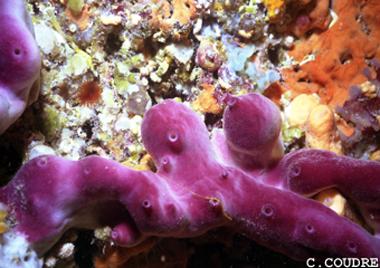| Petrosiidae () |
|
|
sessile; marine; depth range - 5 m |
| Mediterranean. |
|
Very variable morphology: crusts massive, reticules, reniform or irregular, thick several cm. Surface more or less smooth, with many oscules, with relatively uniform distribution. Consistency lasts. Coloring varying of the pure white to brown to nuances violets. Interior of sponge also of clear color (Ref. 358). |
| Habitat: Various rock funds, caves and cracks, generally beyond 5 m and until the great depths. Biology: coloring is related to the presence of symbiotic algae: the non exposed fabrics and the individuals living inside underwater excavations are clear, which is explained by the absence or the scarcity of these chlorophyllian algae. In all the other cases, these spongiae is of darker color. The dory Peltodoris atromaculata almost exclusively nourishes fabrics of this species, whose each colony is frequently the prey of many specimens. As for sponges while not comprising, it is not rare to detect these traces of bites in the form of prints faded in the extreme cases; only one Petrosia sp. can be the prey of 40 mackled dory of all sizes (Ref. 358). |
|
Not Evaluated (N.E.) Ref. 123251)
|
|
|
Source and more info: www.sealifebase.org. For personal, classroom, and other internal use only. Not for publication.

